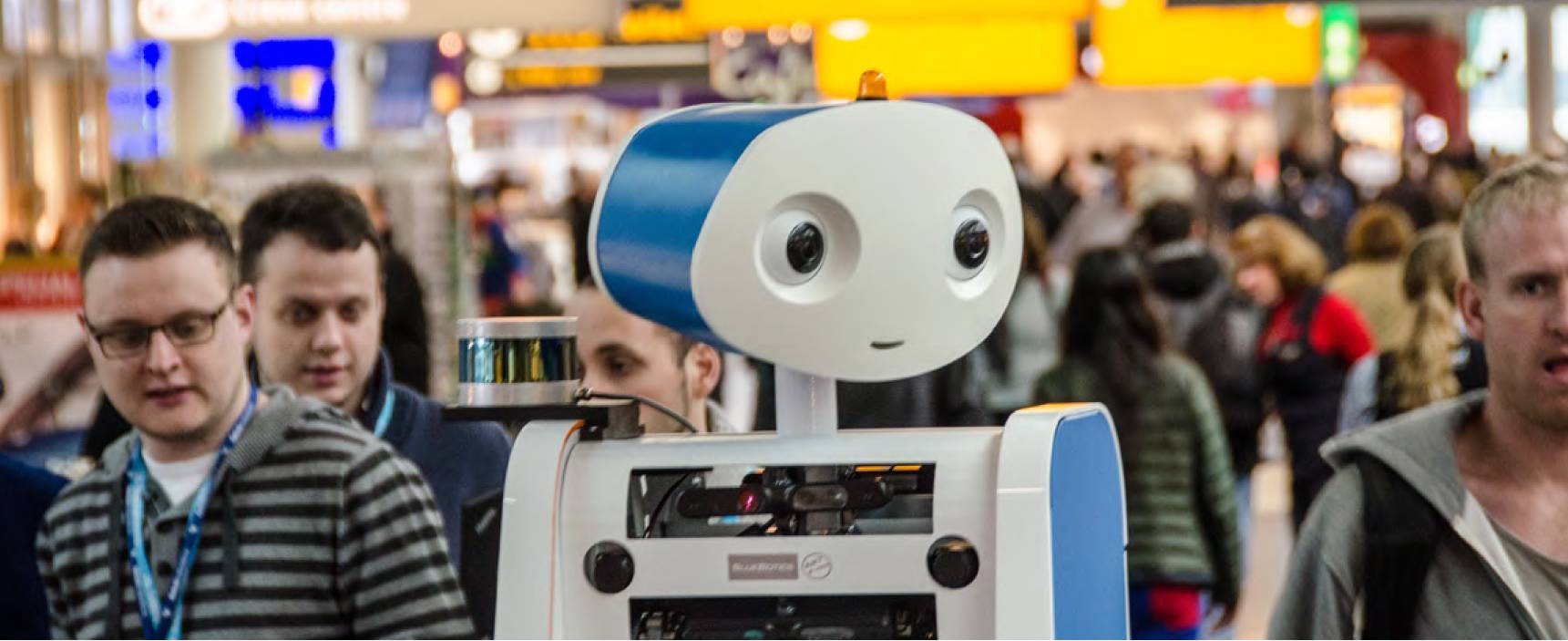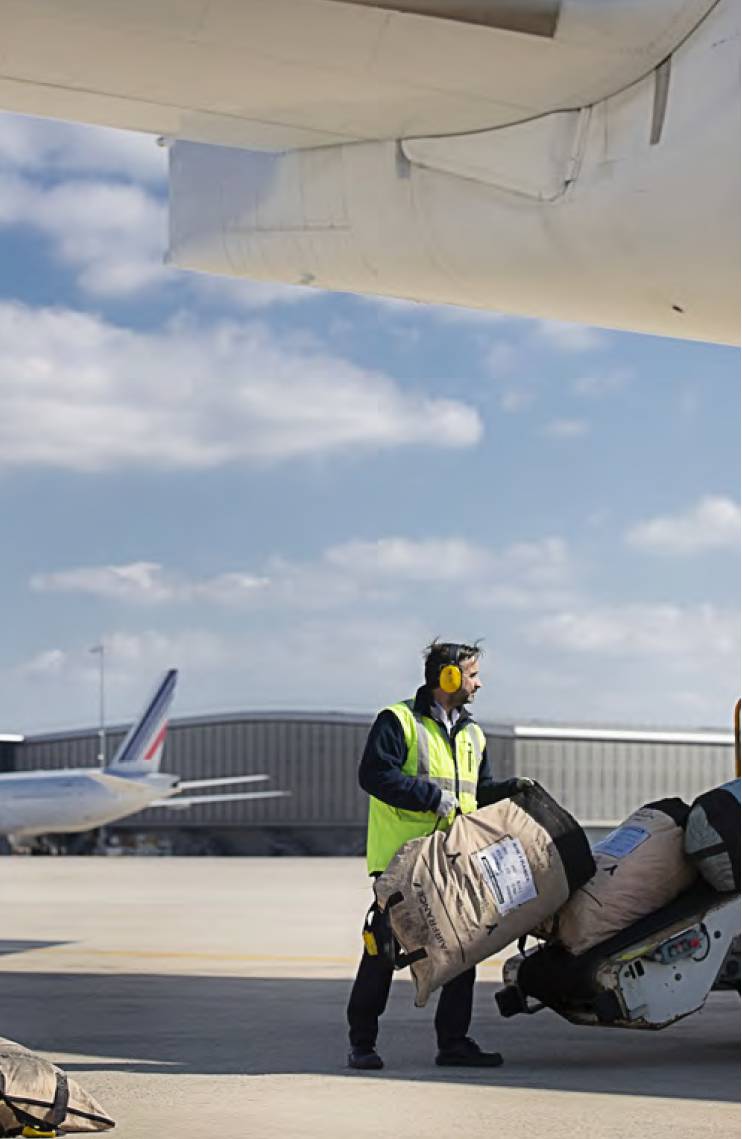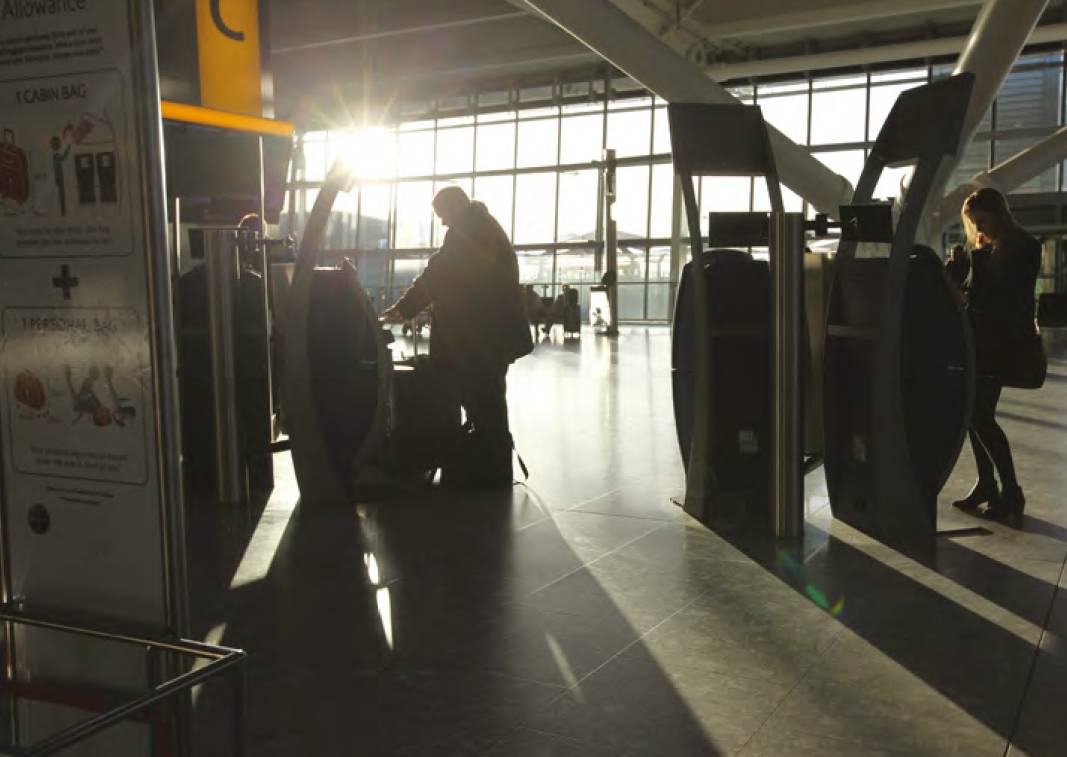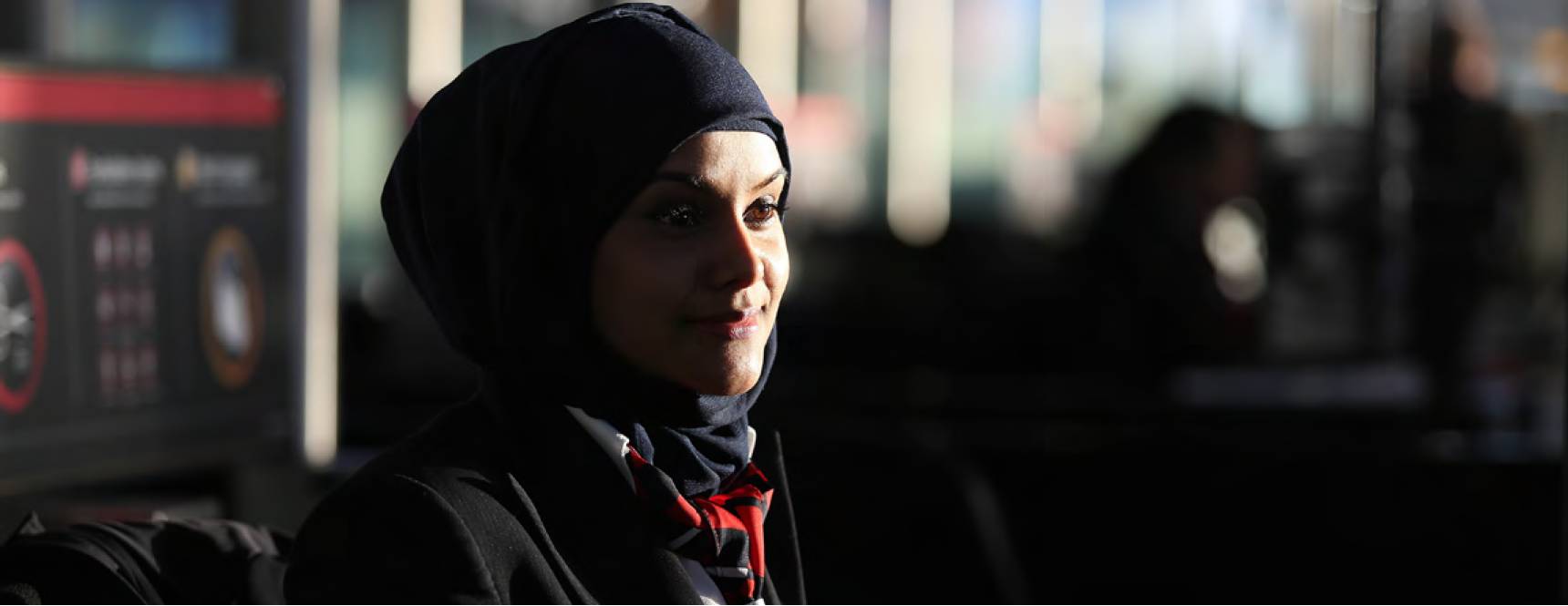AIR TRANSPORT Airport service personnel
Restart from the ground up
ANDY FLETCHER, PAUL HARRIS and DAVID MORIARTY from the RAeS Human Factors Group ask whether the traditional model of ground-handling operations is fit for purpose in a post-Covid world.
 Is this the shape of things to come? KLM’s robot, Spencer, completed tests guiding KLM passengers at Schiphol in 2016. KLM
Is this the shape of things to come? KLM’s robot, Spencer, completed tests guiding KLM passengers at Schiphol in 2016. KLM
Since before the millennium, the public has come to expect the cost of flights to be lower than nearly all other forms of transport. With margins tightening to meet this expectation, the ground operation (a necessary but non-revenue generating activity) has been under scrutiny. At that time, we were using equipment and procedures that were recognisable from the early days of air travel and were quite resource-heavy. The drive towards economy forced change and innovation. However, have we reached a point where our enthusiasm to meet flyers’ expectations has pushed the industry a little too far?
We understand that all airlines are, first and foremost, businesses. Indeed, some of the changes have had very positive results. For example, load control had varying success in achieving good trims for flights depending on the load controller. A well-trimmed aircraft results in a lower fuel burn and can generate significant cost savings. Training up enough load controllers to cover all duty shifts is expensive and results were ‘inconsistent’, with some still only just managing to achieve legal trims. The drive to minimise fuel costs led to tighter requirements for efficient trim targets. This drove the industry to invest in automated load control systems that have led to more consistent processes than ever.
Tickets with perks
Many carriers removed the traditional ‘all-in’ price of the flight ticket. An additional service charge was levied on those who wanted food, priority boarding or to take extra bags. This in turn drove a behavioural change in passengers, with more people taking only cabin baggage. This meant fewer staff were required to load bags or cater to the aircraft and, consequently, the turnaround times were shortened. The ultimate outcome was that resources used in ground operations, particularly one of the highest costs – people – could be reduced.
Out went the dispatcher’s role, the person who traditionally directed turnarounds with authority over all aspects and skills to deal with any eventualities. The industry empowered the passengers by letting them check-in at home, thus reducing the required passenger services staff. We replaced local load control with a centralised load control using automated systems. Automatic gate readers were introduced, reducing gate staff. Additional operational resilience became less frequently required and so its cost was questioned and, in many cases, cut. Some ground operations providers did not survive this process.
Faceless flying?
When we lost check-in desks, we perhaps lost the more personal side of flying. More importantly, we lost an essential barrier in preventing people boarding who were not fit to fly, for example, due to intoxication.
 Delta
Delta
The check-in desk staff checked passports and visas and could help allocate seating appropriate to passengers’ mobility, the aircraft layout or the needs of the aircraft’s trim. There also appears to be less tolerance and more frustration from passengers when they see no one on hand to help or when they encounter long queues. All this has put the onus increasingly on the flight crew to deal with. The crew increasingly handled the fuelling, load sheet and passenger issues while also under the same pressure to achieve their tasks during the turnaround. Without the resources that contributed to operational resilience, the ability to deal with off-schedule (early or late) aircraft often leads to waiting for equipment and staff to arrive. Any out-of-sequence aircraft plays havoc with the programme and can have knock-on effects for the rest of the day, causing stress to flight and ground crews.
The cuts made in the hope of improving efficiency have happened. Skilled but more expensive staff are sidelined in favour of cheaper but less experienced ground crew. Once employed, the work is hard. As a loader, even if you are young and fit, you will be stacking hundreds of bulk bags (sometimes 25-30kg plus) in a hold where you cannot stand up. In summer, aircraft holds can be plus 50C degrees and in winter, –10C, along with storms and high winds. Neither the organisation nor the aircraft operators tend to view this as particularly fulfilling or valuable work. However, we must appreciate the vital job these loaders do.
Passenger staff are affected as well. Lone agents working at the gate may need to stop passengers who do not have documents, appear drunk or want to take their oversized bag into the cabin. Agents’ interventions can lead to them being bullied, intimidated, threatened or physically assaulted.
Flight path – career path
 Air FranceFor many ground staff, remuneration is less than they would get stacking shelves at the local supermarket. Career progression is also more difficult, making this side of the industry less attractive. Thirty years ago one could start building experience as a loader or passenger agent. This career could then progress to supervisory, dispatch, load control and then into the airports and airline operations, cabin crew and flight crews. Now that this traditional career path is a thing of the past, many are avoiding ground operations as an entry into aviation. Colleagues have observed fewer and fewer young people are seeking employment in ground operations which leaves an increasingly ageing workforce.
Air FranceFor many ground staff, remuneration is less than they would get stacking shelves at the local supermarket. Career progression is also more difficult, making this side of the industry less attractive. Thirty years ago one could start building experience as a loader or passenger agent. This career could then progress to supervisory, dispatch, load control and then into the airports and airline operations, cabin crew and flight crews. Now that this traditional career path is a thing of the past, many are avoiding ground operations as an entry into aviation. Colleagues have observed fewer and fewer young people are seeking employment in ground operations which leaves an increasingly ageing workforce.
This feeling of fewer people joining is not speculative either. For two years or more before the current pandemic hit, senior ground operations managers were already raising concerns that recruitment was becoming more and more difficult.
The baggage of baggage staff
While more advanced ground operations automation is on the horizon, no one has yet designed a bag stacker that will fit into the myriad of aircraft types being operated. Small operations will certainly rely on humans for many years. However, driverless pushback tugs, steps, baggage tugs, airbridges and belt loaders are already being evaluated. Powered wheel hubs could allow the aircraft to self-manoeuvre on the ground without running engines or using a tractor unit. Load control systems become better and are learning route profiles to anticipate problems. However, we need to remember the lessons learnt during the 1960s, 1970s and 1980s when it came to flight deck automation; the notion that ‘automation will get us out of trouble’ must be carefully challenged at every turn in the design and training phase as it rarely works out that way.
The future of ground operations
As we have laid out, it was clear that the ground operations sector was facing many challenges even before Covid-19 struck. The global lockdown, the subsequent shutdown of the industry and associated staff layoffs have caused many to consider whether they want to stay in aviation. Many decided it was the catalyst needed to retire a little earlier than expected or retrain and move elsewhere. Some have since spoken about the relief of being out of ground operations. The pandemic gave them the push they needed to leave an industry which they no longer enjoyed or in which they no longer felt valued.
COLLEAGUES HAVE OBSERVED FEWER AND FEWER YOUNG PEOPLE ARE SEEKING EMPLOYMENT IN GROUND OPERATIONS WHICH LEAVES AN INCREASINGLY AGEING WORKFORCE
Everyone is now waiting for the big switch-on when airlines reintroduce their flight programmes and people’s pent-up desire to travel leads to the inevitable surge in air travel. We have to question whether the increasingly dire situation in ground operations will impact negatively on this.
There are calls for risk assessments from regulatory and trade bodies but the industry safety representatives are among those most likely to have left the industry. When operators and their contractors’ management re-evaluate their old risk assessments, they must consider a presently unknown factor: the (probable) loss of the ‘old hands’, the people who we had relied upon to deliver all the on-the-job training. These were the respected staff with years of experience who could identify and resolve evolving problems early on and look after the new recruits. We have no idea yet if they will come back. Waiting to see or hoping that they reapply is not enough. Operators need to start making efforts to definitively evaluate how many might be returning. If the numbers are not sufficient, it may be time to reconsider the terms and conditions that these experienced operators can expect to receive.
Crucially, airlines need to consider the state of ground operations in their restart plans. They also need to factor in that their third-party providers may have five, six or more other airlines who all need to restart their own operations. Many airlines and ground organisations are teetering on the brink of survival. It would be all too easy for commercial teams to demand (or promise) a programme that the operational ground teams are unable to deliver safely. Everyone needs to be realistic with their initial and increasing demands on their contractors. Providers must offer what is safely deliverable and commercial pressure to become operationally over-committed, with the subsequent consequences for safety, must be resisted.
Training and recruiting in a postCovid age
 British AirwaysA realistic minimum recruitment, training, and lead-in period to get someone who can effectively work alone is four months. Security clearances can slow the process further. As the industry restarts, it may be that trainers and line expertise does not return. In that scenario, assessing how formal and on-the-job training can be completed needs to be considered carefully. In order to sufficiently shorten the lead-in time to satisfy the demand for new staff, training may need to begin even without a guarantee of granting a security pass. Those fortunate to have stayed employed and those experienced and returning to the industry are likely to be busy. They will be relied upon to train, educate, and protect those new recruits less aware of ground operations hazards. Organisations should ensure they monitor and address any real (or perceived) pressure these staff may feel they are under. The welfare of these crucial members must be regularly reviewed to avoid overloading or another detrimental impact to the operations.
British AirwaysA realistic minimum recruitment, training, and lead-in period to get someone who can effectively work alone is four months. Security clearances can slow the process further. As the industry restarts, it may be that trainers and line expertise does not return. In that scenario, assessing how formal and on-the-job training can be completed needs to be considered carefully. In order to sufficiently shorten the lead-in time to satisfy the demand for new staff, training may need to begin even without a guarantee of granting a security pass. Those fortunate to have stayed employed and those experienced and returning to the industry are likely to be busy. They will be relied upon to train, educate, and protect those new recruits less aware of ground operations hazards. Organisations should ensure they monitor and address any real (or perceived) pressure these staff may feel they are under. The welfare of these crucial members must be regularly reviewed to avoid overloading or another detrimental impact to the operations.
Assessing expectations
The industry should assess what passenger expectations will be like in the post-Covid-19 world too. Managers and trainers should determine what training is provided for staff to defuse or deescalate effectively, especially where supervisory or other support may be unavailable in a timely fashion. This is now an integral part of cabin crew training material. Operators should look at the benefits of sharing such material with their contracted handling agents to provide a good service for their passengers and help with onboard safety.
 British Airways
British Airways
More than ever, all parties contributing to the aviation environment need to work together to understand the extraordinary nature of this industry restart. Flight crews and managers need to understand and be advised about the difficulties and pressures facing front-line staff discussed here. There will likely be some anger and frustration from all sides over the next few years.
The combination of pre-pandemic industry problems and the pressures that we can expect in the post-pandemic start-up may be a perfect storm. At the very least, it should lead us to ask whether this ‘lowest possible cost’ business model for ground operations is fit for purpose? In aviation, we pride ourselves on being an industry with an open questioning culture, one that welcomes evidence prompting us to review what we do and seeing if it could be better or safer. Paying the lowest possible price for a service always has consequences. With the historic under investment in ground operations, we should ask whether we are reaching a point where safety, passenger experience and the sector’s resilience have been critically degraded. It is our hope that assessment of the emergent risks and sensible investment and management in ground operations will help get us through this critical restart period with minimal disruption so that the industry can emerge better, stronger and safer.
 Is this the shape of things to come? KLM’s robot, Spencer, completed tests guiding KLM passengers at Schiphol in 2016. KLM
Is this the shape of things to come? KLM’s robot, Spencer, completed tests guiding KLM passengers at Schiphol in 2016. KLM


